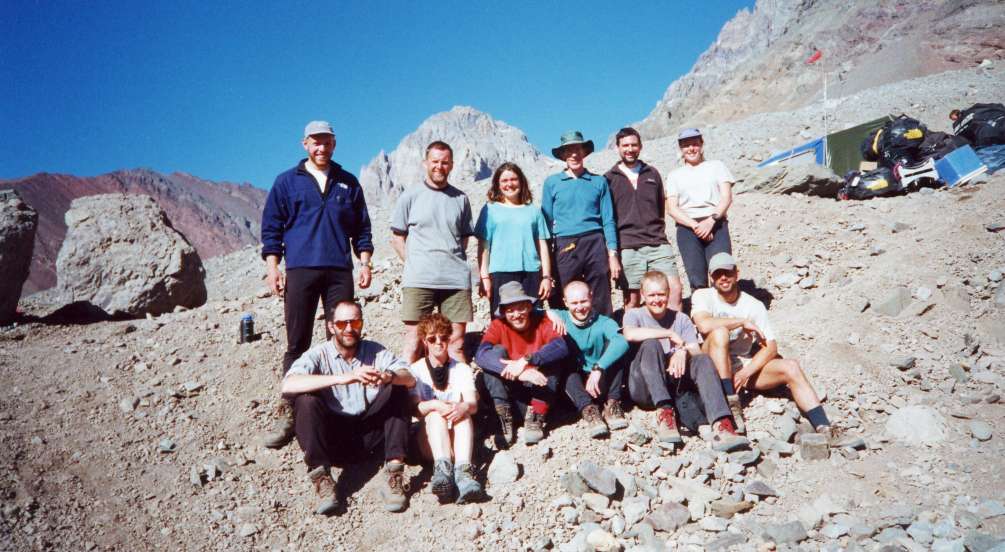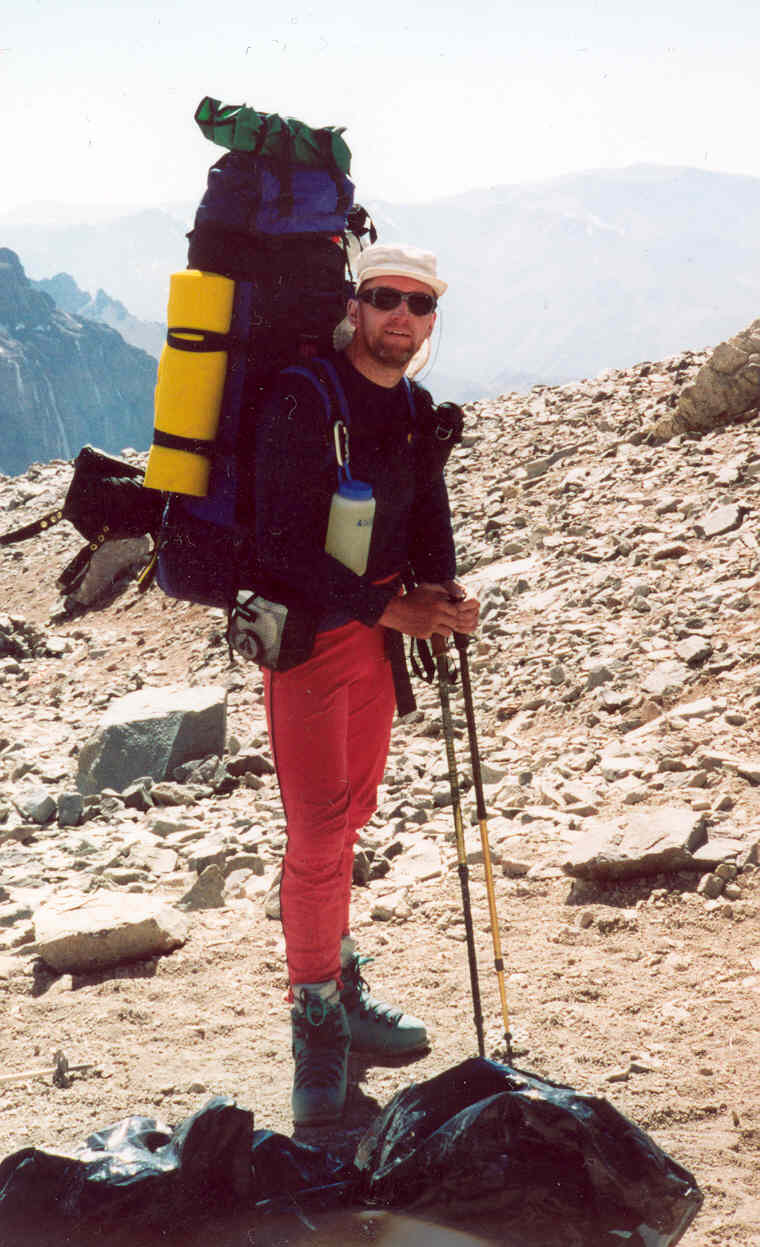


| Day | Itinerary |
|---|---|
| 1 | Fly to Mendoza and stock food and provisions |
| 2 | Drive to Los Penitentes for an overnight stay |
| 3 | Load the Mules and walk to first camp at Las Lenas (2,700m) |
| 4 | Walk to second camp at Casa Piedra (first view of Aconcagua) (3,200m) |
| 5 | Walk to Base Camp (4,200m) |
| 6 | Rest Day |
| 7 | Rest Day |
| 8 | First Load Carry to Camp 1 (4,900m) |
| 9 | Rest Day |
| 10 | Second Load Carry to Camp 1 |
| 11 | Rest Day |
| 12 | Third Load Carry to Camp 1 |
| 13 | Rest Day |
| 14 | Move Up to Camp 1 |
| 15 | Rest Day |
| 16 | Load Carry to Camp 2 (5,900m) |
| 17 | Rest Day |
| 18 | Load Carry to Camp 2 |
| 19 | Rest Day |
| 20 | Move Up To Camp 2 |
| 21 | Rest Day |
| 22 | Summit Day (6,952m) |
| 23 | Descent To Base Camp |
| 24 | Rest Day |
| 25 | Rest Day and kit sort |
| 26 | Load Mules and walk out to Casa Piedra |
| 27 | Walk out to Trailhead and drive to Mendoza |
| 28 | Free day in Mendoza |
| 29 | Fly Home. |
This is the highest mountain in South America and the one of the Seven Summits. These are the highest mountains on each of the Seven Continents.
| Continent | Mountain | Altitude | Asia | Everest | 8850m | South America | Aconcagua | 6962m | North America | McKinley (Denali) | 6194m | Africa | Kiliminjaro | 5895m | Europe | Elbrus | 5642m | Antartica | Vinson | 4897m | Australasia | Carstenz Pyramid | 4884m |
|---|
Outside of the Himalaya, Aconcagua is the highest mountain in the world, and in January 2001, I was privileged enough to be on a team as one of the two Climbing Team Leaders flying out from Gatwick to Buenos Aires to climb it.
Organising a trip like this is a huge responsibility and we were lucky enough to have Danny Crossman as our Expedition Leader. Danny is ex-military and well used to dealing with the likes of us. Each person had a job to do. Mine was mainly in the build up to the trip, being responsible for team training and fitness, to which end, I wrote a specific training plan and organised several weekends walking and climbing. Whilst on the trip, my chief responsibility would be the actual climbing. Others were responsible for food, hiring of mules, equipment etc.

There was a type of hierarchy within the group, Danny was at the top and Leader, Brian, a Commander in the Navy, was Base Camp Manager and second in command. Alex (Major) and myself were next in line. Being a climber though, I wasn't really interested in taking charge of day to day stuff, preferring to let others do that and just concentrating on the climbing and logistical aspects of moving people and gear up the mountain.
Mendoza is the normal starting point for this climb, and indeed, whilst we were there, we met others who had finished the climb. Mendoza is also the place to go food shopping and for this, you need a guide and a large vehicle. There are loads of 'Tour Operators' who will provide any or all of the services you need and they are reasonabably cheap-search the Web for 'Andes' or 'Aconcagua'. It is well worth it, otherwise you can waste a lot of time trying to find things. Finally, you need a permit to go to the Mountain. This is obtained in Mendoza for $150, but includes rescue costs.
The drive from Mendoza to the trailhead at Los Penitentes takes about three hours and goes through some fabulous countryside. Don't get too excited though, there is never a view of Aconcagua itself. In fact you have to wait until the end of the second days walk in before seeing it, but it is well worth it.
Near the trailhead, there is a view of Tupungato - at 35 miles distance and 5,500m high - it is well impressive.
Walking in to Base Camp takes three days, but is fairly easy for the first two.
The secret is to take it easy - as it is for the whole trip really, and allow your body to acclimatise as slowly as possible. The first two days only gain a few hundred metres in height and in fact at the end of the second day, you are at 3,200m, having started at 2,400m. Day three of the walk in climbs 1,000m to Base Camp, but you don't really notice as there is a lot of time spent crossing and recrossing the river which takes a lot of concentration. Also it is steep, so you kind of expect to be tired anyway.
Once at Base Camp, the job of organising the food and equipment begins, as does the load-carrying to Camp 1. We had a couple of days rest before the first carry, and boy, did we need them. Base Camp life is tiring. You think you can do stuff as normal, but find very quickly that even simple jobs become exhausting.
There were four load carries including the move up, so we got pretty used to the route. On our rest days, we either did nothing at all, went Bouldering or tried to wash clothes and body as best we could.

Camp 1 was somewhat less appealing than Base. Here rest days meant just that. Eat, drink, shit, read and sleep were the only jobs to be done. Load carries to Camp 2 were exhausting, but thankfully we only had two to do including the move up.
Camp 2 is a huge toilet. You pitch where you can and try to find a place as a toilet where no-one else will pitch. Clearly other occupants were not so thoughtful and one has to be careful to avoid excrement. Fortunately it dries quickly and there is no smell. The walk-up is extremely tiring, but life at the camp is not too bad. The first night we were there I felt really bad, nauseous, tired, no appetite - the usual stuff, but I force fed myself, took a couple of Paracetamols and was fine after a couple of hours. That was all I suffered.
Summit Day started at 4:00am for me, although some had been up since 3:00am. I have no idea what they did for 2 hours, but we left at 5:00am, or tried to. One of our group had a dodgy headtorch - should have checked, so we had to wait for that to be fixed. By about 6:30am it was light enough to do without torches and soon after that, warm enough to do without Down Jackets so they were stashed away.
The climb to the summit took us 11 1/2 hours to complete, with no more than a couple of decent stops. At that altitude, every step is tiring and it hurts all the way. We stood on the summit at 4:30pm with loads of other people, took the usual set of photos, then began the 5 1/2 hour descent.

We finished, totally exhausted in the dark at 10:00pm, and after a couple of drinks, just went to bed.
The next day, we all felt pretty good, but one of two were suffering from mild Oedemas, so we made the decision to split into two groups. One group - those that had summited, plus Linda and Brian would descend to Base Camp, the rest, plus Dr Jeremy and Paul would stay for a second attempt the following day - which sadly failed due to bad weather.
The descent was easy enough and as we came down, began to feel pretty good about ourselves. Once at Camp 1 though, we had to pick up the rest of our gear which made the 'sacs unbelieveably heavy, so the descent from Camp 1 to Base was quite tough.

There were 16 people in the team. A few had to be evacuated due to various illnesses with just remaining 12 at the end of the trip.
Matt had to leave the trip after only one day due to a virus. Keith was evacuated from Base Camp on the first day due to a Pulmonary Oedema (HAPE). Danny, similarly was evacuated with HAPE but not before reaching Camp 2 at 5,900m. Richard left two days earlier to check on Danny who was in Hospital.
We did the trip for three main reasons:
1. To climb the mountain (obviously)
2. To raise money for the SSAFA Charity (Soldiers, Sailors and Airmens Families Association).
3. To do some research into High Altitude Acclimatisation.
Well, we did climb the Mountain, we raised over £6,000 for the charity and did some useful research, so we achieved all our goals.
Official DERA Website